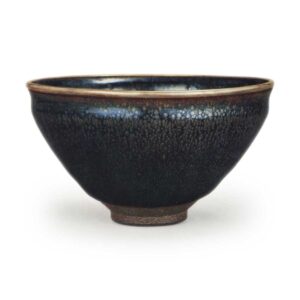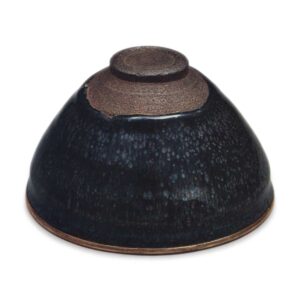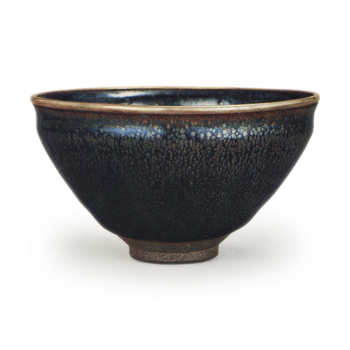

Name: Hoshikenzan
Tokugawa Art Museum
Height: 7.1cm
Diameter: 12.2cm
Base diameter: 3.8cm
Height: 0.5cm
This tea bowl, which has been handed down in the Owari Tokugawa family, has long been called “Hoshikenzan”. The reddish-black, rough, hard clay is clearly from the Ken kiln. As usual, the foot of the bowl and the foot ring have been beautifully turned on the potter’s wheel, and the inside of the foot ring has been carved slightly deeper than usual.
The glaze is a jet-black, glassy color, and it is covered in countless oil droplets on both the inside and outside. These oil droplets are not round and well-shaped like those of the Ryuko-in or the Fujita Museum, but are irregularly shaped and of various sizes. On the outside, the oil drops are densely packed, and each drop is a relatively dark brown. If you look closely, you can see that the center of each drop is made up of iron sand. The surface of the glaze on this teacup is covered with the film that gives off an iridescent sheen, but the iridescence is not very vivid here, perhaps because the oil drops are darker in color.
On the other side (around the foot ring), the oil spots are more sparse and the color is a very light brown. There is no iron sand condensation like on the side view, and it looks dull silver with the black glaze as a background. There are also many areas where the grains have run down to form a rabbit-hair pattern. Because the oil spots are sparse and the color is light, the black glaze underneath is strongly visible, and the iridescence is much more vivid than on the front surface. This is particularly noticeable in the area with the large light-colored grains (around the center of the foot ring), and it is not too much to say that this area alone is yohen.
The name “Hoshiken-san” probably comes from this area. In a sense, this tea bowl combines the characteristics of both Yohen and Yudeki.
As mentioned above, the way the Yudeki is scattered on the exterior is uneven, but on the interior it is almost evenly scattered. About seven-tenths of the way down from the rim, the vessel wall is gouged out to deepen the inside, but up to this point the glaze has flowed and the layers are thin, so the oil spots do not connect. Then, from the point where the inside widens, the grains begin to connect and reach the bottom. The start of these grains is somewhat sparse in terms of the occurrence of oil spots, and the color is also light. Therefore, it presents the same yohen phenomenon as the sparse part on the outside.
In short, this teacup can look like either an oil drop or a yohen depending on the angle of the light, and it is a teacup with a lot of subtle details to enjoy. Incidentally, it should be noted that teacups with iridescent glaze surfaces like this one can change their color tone drastically depending on the quality and quantity of the light. I saw this in natural light on a fall afternoon, and the color is quite different from the color in the photo. Of course, it’s different from a photo taken in a dark studio with only strong electric lighting. This difference is inevitable, and the next time I see it, it may look a different color again. It is a truly bewitching teacup.
There is nothing in particular to see as an accessory.



